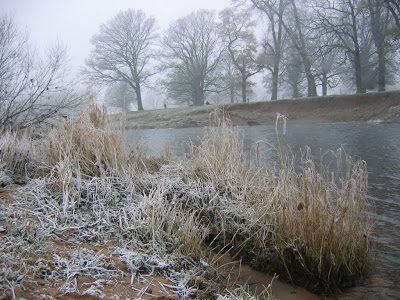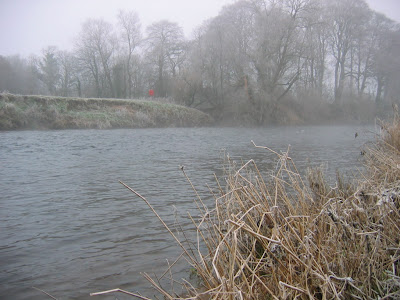So far December has been a complete loss as far as Grayling outings are concerned, the river has been up every weekend, snow melt brought it up the first weekend and rain in the latter half of weeks two and three meant those weekends were lost also.
My last outing was a short affair at the end of November - it was during the cold spell, the day started and stayed bitterly cold with a severe frost and a freezing mist hanging over the river.

I'd decided not to bother but by lunchtime temptation had got the better of me so I loaded my gear into the van - that was after thawing my wading boots - they were frozen stiff after being in the garage all night.
I don't know if you've heard the saying 'More skins than an onion' but that was me today - my neoprene waders are leeking so it was out with the gortex ones and to make up for the lack of insulation 4mm of neoprene provides, I had a few layers on - two pairs of thermal longjohns, a pair of thick fleece pants, two pairs of socks, thermal vest and two fleece shirts - I could hardly move !

I got to the river at 2 o'clock, so it would be a short session as it would be dark by 4.30 - it was too cold for anything longer anyway.
The start couldn't have been better with fish 2nd, 3rd and 4th casts, all coming to a pink bug - pink works really well for me at this time of year.
These fish all came on the hang - which was surprising as I expected them to be deep in the cold and lifeless conditions, the rest of my catch didn't disappoint with all coming when the flies were at their deepest - takes were gentle with only the slightest movement indicating a take but all fought well.
It was too cold to get my hands wet so they were played to within reach as quickly as possible then gripping the barbless fly, the fish were shaken off and all swam off without any problem.

So my last outing was very cold and very short, and now after a few lost weekends I'm desperate to get out again - looking at the river and the weather forecast it looks like it's this weekend.
Merry Christmas and many tight lines in 2009 to you all






